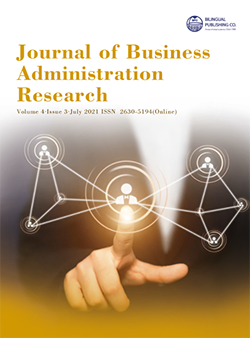A Study on Income as a Determinant of Buying Decision-making Styles
DOI:
https://doi.org/10.30564/jbar.v4i3.3193Abstract
The following paper attempts to understand if income determines the buying decision-making styles of consumers in Bhubaneswar, the capital city of Odisha, a state located on eastern India. A total of 103 respondents of Bhubaneswar were chosen by using the Mall intercept method. The samples were classified into three groups based on their average annual family income such as High Income, Middle Income and Low Income groups. Exploratory Factor Analysis was carried to identify the decisionmaking styles. ANOVA was employed to compare the shopping styles of these three income sub-groups. Results indicate that differences in consumer shopping styles exist among the income sub-groups. Findings of the study can be used by marketers for segmentation, targeting and positioning of retail shoppers which may facilitate them to compete efficiently. It is recommended that different income sub-groups should be viewed as distinct consumer segments and strategies should be formulated to cater each segment effectively.
Keywords:
Income; High income group; Middle income group; Low-income group; Consumers; Consumer decision-making styleReferences
[1] Jorgensen, J. (1979). Cross-cultural comparisons. Annual Review of Anthropology, 8,309-331.
[2] Hofstede, G. (1983). National cultures in four dimensions: a research-based theory of cultural differences among nations. International Studies of Management Organization, 13(1-2), 46-74.
[3] Babin, BJ & Harris, EG. 2012. CB4. Mason. SouthWestern Cengage Learning.
[4] Kamaruddin,AR & Mokhlis, S. (2003). Consumer socialization, social structural factors and decisionmaking styles: A case study of adolescents in Malaysia. International Journal of Consumer Studies, 27(2),145-156.
[5] Walsh, G., Thurau, T., H., & Mitchell, V.-W. (2001). Consumers' decision-making stule as a basis for market segment. Journal of Targeting, Measurement and Analysis for Marketing, 10(2), 117-131.
[6] Makgosa, R.(2014).The Role of Demographics on Decision-Making Styles of Botswana’s Retail Shoppers, Research in Business and Management, 1(2), 32-54.
[7] Ailawadi, K. L., Neslin, S. A., & Gedenk, K. (2001). Pursuing the value conscious consumer: store brands versus national brand promotions. Journal of Marketing, 65(1), 71-89. http://dx.doi.org/10.1509/ jmkg.65.1.71.18132.0.
[8] Turell, G. (2002). Socio-economic differences in food purchasing behavior and suggested implications for diet related health promotion. Journal of Human Nutrition and Dietetics, 15(5), 355-364.
[9] Ghani, U., & Jan, F. A. (2011). An Exploratory Study of impulse buying of Urban Consumers in Peshawar. International Conference on business and Economics Research.
[10] Zeithaml, V. A. (1985). The new demographics and market fragmentation. Journal of Marketing, 49(3), 64-75.
[11] Girard, T., Korgaonkar, P., & Silverblatt, R. (2003). Relationship of types of product, shoppingorientations and demographics with preference for shopping on the internet. Journal of Business and Psychology, 18(1). 101-120.
[12] Sasirekha A.(2020). Analysis on decision-making styles and clothing choice criteria of working women in buying apparel in Chennai. Journal of Information and Computational Science,10 (1),192-203.
[13] Mitra Saleh, Seyed Erfan Alhosseini, and Alireza Slambolchi (2017), A Review of Consumer DecisionMaking Styles: Existing Styles and Proposed Additional Styles. International Journal of Research in IT, Management and Engineering, 7 ( 1), Page 33- 44.
[14] Sproles, G. B., & Kendall, E. L. (1986). A methodology for profiling consumers’ decision making styles. Journal of Consumer Affairs, 20(2), 267-279.
[15] Hafstrom, J. L., Chae, J. S., & Chung, Y. S. (1992). Consumer decision making styles: Comparison between United States and Korean young consumers. The Journal of Consumer Affairs, 26(1), 146-158.
[16] Durvasula, S., Lysonski, S., & Andrews, J. C. (1993). Cross-cultural generalizability of a scale for profiling consumers’ decision-making styles. The Journal of Consumer Affairs, 27, 55-65.
[17] Lysonski, S., Durvasula, S., & Zotos, Y. (1996). Consumer decision-making styles: A multi-country investigation. European Journal of Marketing, 30(12), 10-21.
[18] Mitchell, V.-W., & Bates, L. (1998). UK Consumer Decision-Making Styles. Journal of Marketing Management, 14(1-3), 199-225. DOI: 10.1362/026725798784959345.
[19] Hiu, A. S., Siu, N. Y., Wang, C. C., & Chang, L. M. (2001). An Investigation of Decision‐Making Styles of Consumers in China. Journal of Consumer Affairs, 35(2), 326-345.
[20] Tarnanidis, T., Owusu-Frimpong, N., Nwankwo, S., & Omar, M. (2014). A confirmatory factor analysis of consumer styles inventory: Evidence from Greece. Journal of Retailing and Consumer Services, 22, 164- 177.
[21] Nayeem, T., & Casidy, R. (2015). Australian consumers’ decision-making styles for everyday products. Australasian Marketing Journal (AMJ), 23(1), 67-74.
Downloads
Issue
Article Type
License
Copyright and Licensing
The authors shall retain the copyright of their work but allow the Publisher to publish, copy, distribute, and convey the work.
Journal of Business Administration Research publishes accepted manuscripts under Creative Commons Attribution-NonCommercial 4.0 International License (CC BY-NC 4.0). Authors who submit their papers for publication by Journal of Business Administration Research agree to have the CC BY-NC 4.0 license applied to their work, and that anyone is allowed to reuse the article or part of it free of charge for non-commercial use. As long as you follow the license terms and original source is properly cited, anyone may copy, redistribute the material in any medium or format, remix, transform, and build upon the material.
License Policy for Reuse of Third-Party Materials
If a manuscript submitted to the journal contains the materials which are held in copyright by a third-party, authors are responsible for obtaining permissions from the copyright holder to reuse or republish any previously published figures, illustrations, charts, tables, photographs, and text excerpts, etc. When submitting a manuscript, official written proof of permission must be provided and clearly stated in the cover letter.
The editorial office of the journal has the right to reject/retract articles that reuse third-party materials without permission.
Journal Policies on Data Sharing
We encourage authors to share articles published in our journal to other data platforms, but only if it is noted that it has been published in this journal.




 Adyasha Suvadarshini
Adyasha Suvadarshini

